The Pointer Stars are the two bright stars in Ursa Major that can be used to find Polaris, the North Star. The two stars, Dubhe and Merak (Alpha and Beta Ursae Majoris), are part of the Big Dipper asterism. They outline the outer part of the Dipper’s bowl. A line extended from Merak through Dubhe points in the direction of the North Star.
Polaris is important in navigation because it marks the location of the north celestial pole. The star is always found in the same place in the sky throughout the year while other stars and constellations appear to circle around it. Marking the tip of the Little Dipper’s handle (and of the Little Bear’s tail), the star is only 0.66 degrees away from the northern celestial pole and makes a fairly accurate marker of true north. It is invisible to observers south of the equator, but circumpolar for those in northern latitudes. With an apparent magnitude of 1.98, it is the brightest star in Ursa Minor and the 48th brightest star in the sky.
Since the stars of the Little Dipper are not as conspicuously bright as those of its larger counterpart, the Pointer Stars in the Big Dipper are commonly used in navigation to find Polaris and true north. Dubhe, the northern of the two Pointers, is slightly brighter than Polaris, shining at magnitude 1.79.
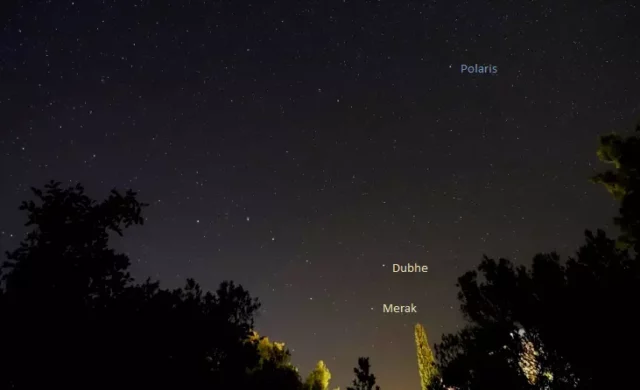
The Pointer Stars in the Big Dipper, image: CG
How to find the North Star
Polaris is the brightest star found along the imaginary line drawn from Merak through Dubhe northward. It does not lie exactly on this line, but it is bright enough to stand out in this area of the sky. The distance from Dubhe to Polaris is about five times the distance between Merak and Dubhe.
The Little Dipper itself can be difficult to find from light-polluted areas because the inner four stars of the asterism are relatively faint. Only Polaris and the two stars marking the outer edge of the Dipper’s bowl are visible from urban areas. These two stars, Kochab and Pherkad (Beta and Gamma Ursae Minoris), are known as the Guardians of the Pole. They appear roughly parallel to Mizar and Alioth, the inner stars of the Big Dipper’s handle.
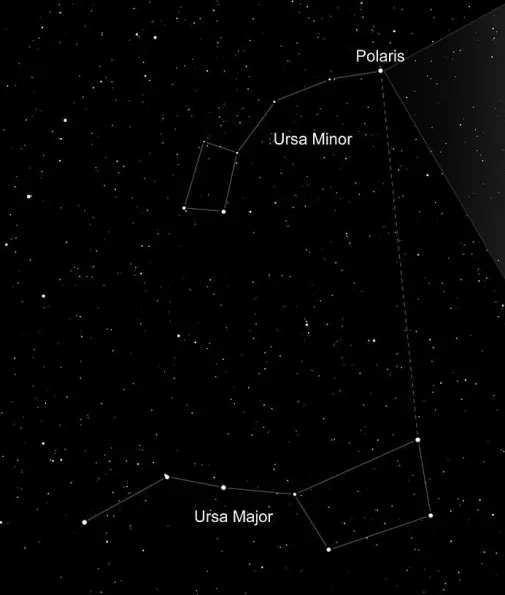
Location of Polaris and the Little Dipper, image: Hubblesite. Credit: NASA, ESA, N. Evans (Harvard-Smithsonian CfA), and H. Bond (STScI)
Also known as the Plough, the Big Dipper is the brightest part of the constellation Ursa Major. Ursa Major is circumpolar for northern observers. It never falls under the horizon and can be seen throughout the year. From mid-northern latitudes, the constellation always appears in the northern sky. In the summer, it can be found in the northwest in the evening and in the winter it hangs upside down in the northeast. Its seven brightest stars form the Big Dipper, one of the most recognizable asterisms in the night sky.
Dubhe, Alpha Ursae Majoris, is the brighter of the two Pointers. It is an orange giant of the spectral type K0III, shining at magnitude 1.79. It has a mass 3.44 times that of the Sun and a radius 17.03 times solar. With an effective temperature of 5,012 K, it is 165.1 times more luminous than the Sun.
Dubhe is the primary component in a spectroscopic binary system also composed of a white main sequence star with the stellar classification F0V. The two stars orbit each other with a period of 44.5 years at a distance of about 23 astronomical units. The system lies approximately 123 light years away.
Merak, Beta Ursae Majoris, is a white subgiant of the spectral type A1IVps. It has an apparent magnitude of 2.37 and lies 79.7 light years away. Like Dubhe, it is larger and more massive than the Sun, with a mass of 2.7 solar masses and a radius 3.021 times that of the Sun. With a surface temperature of 9,377 K, it shines with 63 solar luminosities.
While they are most commonly used to find Polaris, the Pointers can also be used to find several deep sky objects easily observed by amateur astronomers.
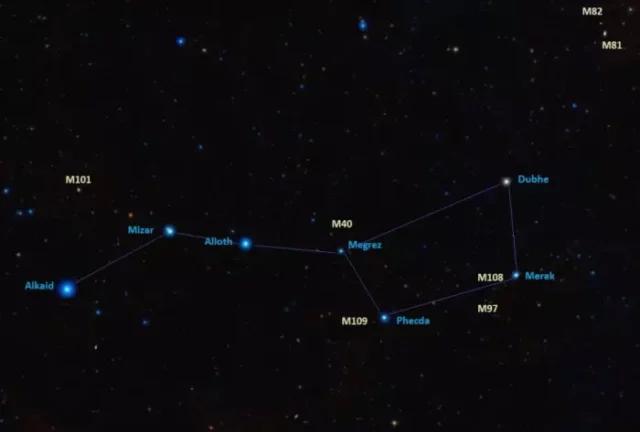
Messier objects near the Big Dipper, image: Wikisky
The bright galaxies Messier 81 and Messier 82, also known as Bode’s Galaxy and the Cigar Galaxy, are found along the imaginary line extended from Phecda to Dubhe by about the same distance as that between the two stars.
Located about 10 degrees northwest of Dubhe, M81 is a grand design spiral galaxy with an apparent magnitude of 6.94 and an apparent size of 26.9 by 14.1 arcminutes. It is the brightest galaxy in the M81 Group, to which the neighbouring M82 also belongs. M81 lies approximately 12 million light years away and spans 90,000 light years.
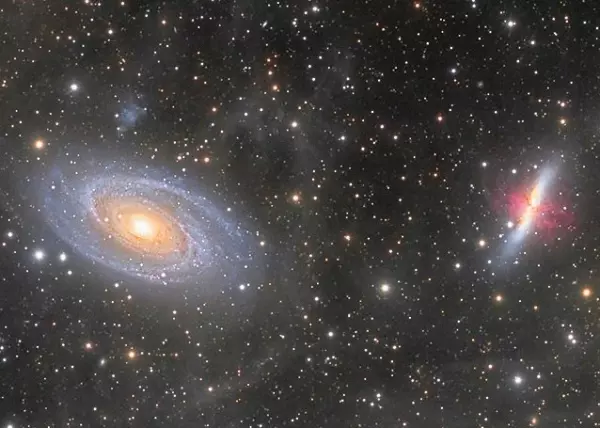
Messier 81 and Messier 82, image: Leonardo Ciuffolotti, Andrea Pistocchini, Giuseppe Nicosia, Alessandro Falesiedi, Tim Stone, Giuseppe Donatiello (CC0 1.0)
M82 is a starburst galaxy located at the same distance. It appears almost edge-on and has an apparent magnitude of 8.41. It occupies an area of 11.2 by 4.3 arcminutes and has a physical diameter of about 37,000 light years. The interaction with Bode’s Galaxy has caused star forming activity to increase tenfold in M82 compared to other galaxies. Many of the massive young stars have already gone out as supernovae.
Merak lies in the proximity of the barred spiral galaxy Messier 108 and the Owl Nebula (Messier 97). Both Messier objects lie within about 2 degrees of the star. Messier 108 has an apparent magnitude of 10.7 and appears almost edge-on. It lies approximately 46 million light years away. The Owl Nebula is one of the four bright planetary nebulae catalogued by Charles Messier. Named for its owl-like appearance, the nebula can be seen in small telescopes. It has an apparent magnitude of 9.9 and an apparent size of 3.4 by 3.3 arcminutes.
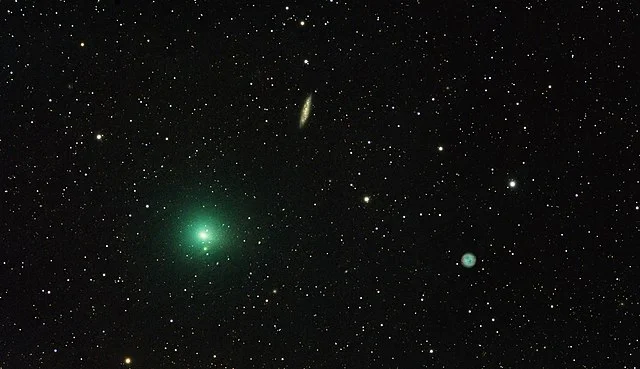
Comet 41P/Tuttle-Giacobini-Kresak near Messier 108 and Messier 97 (the Owl Nebula), March 22, 2017, image: Kees Scherer (CC0 1.0)
Southern Pointers
The Pointer Stars have their counterparts in the southern skies. These are Rigil Kentaurus (Alpha Centauri) and Hadar (Beta Centauri), the third and 11th brightest stars in the sky. However, while the Pointers in the northern hemisphere point directly at the North Pole star, Alpha and Beta Centauri point at the Southern Cross, the bright diamond-shaped asterism that dominates the constellation Crux. The two first-magnitude stars make it easy to distinguish the asterism from the larger and fainter False Cross, formed by four bright stars in the constellations Carina and Vela.
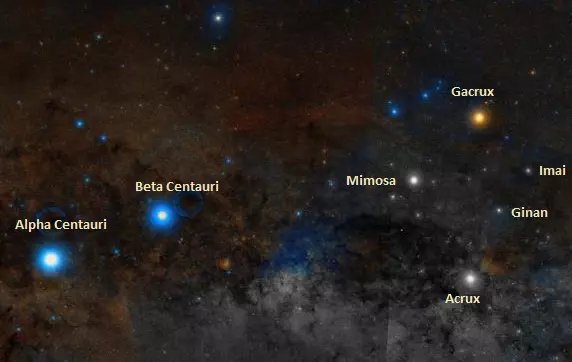
Alpha and Beta Centauri and the Southern Cross, image: Wikisky
The two asterisms – the Southern Cross and the Southern Pointers – can be used to roughly pinpoint the location of the south celestial pole. Polaris Australis (Sigma Octantis), the South Pole star, has an apparent magnitude of 5.47 and is barely visible even in the best of conditions. Even though it is the nearest visible star to the pole, it is too faint to be useful in navigation. For this reason, Alpha and Beta Centauri and the bright stars of the Southern Cross are commonly used to determine the location of the pole.
The south celestial pole can be found by extending a line from Gacrux through Acrux and another line perpendicular to the imaginary line connecting Alpha and Beta Centauri. The point where the two lines intersect is close to the location of the pole. A line drawn from Hadar to the bright Achernar in the constellation Eridanus helps to determine the position of the pole more accurately.
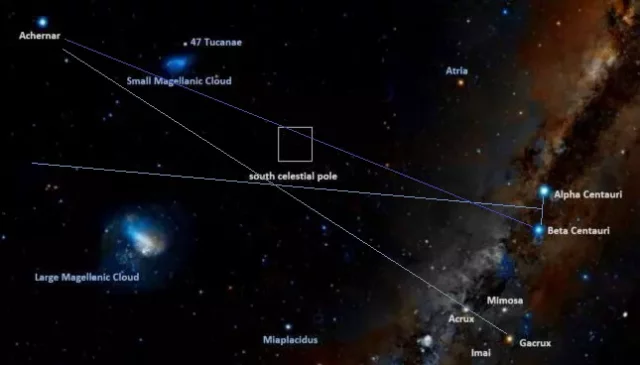
The Southern Pointers, Southern Cross and south celestial pole, image: Wikisky